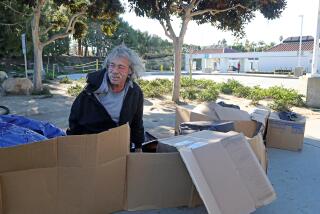Newport Sets Traffic Rules on Balboa Walkway : Safety: The City Council imposes speed limits and authorizes police to use radar to detect violators.
Months of community controversy over a proposal to ban bicyclists and skaters from the Balboa Peninsula boardwalk came to a quiet close Monday night when the City Council approved sweeping changes of traffic rules on the busy oceanfront walkway.
The unanimous action came after little council discussion on the new laws which include an 8-m.p.h. speed limit, new traffic flow directions, penalties for violators and an authorization for police to use radar to nab speeders.
The laws could take effect by mid-February.
“We tried to cover all the bases,” Councilman John W. Hedges said. “I think the things we came up with are responsible. Now, it falls upon the enforcement, and we do plan to enforce it strictly.”
Critics of the new rules had said that few followed existing rules and that only long-range improvements, such as widening the walk, would make the walk safer.
In addition to the speed limit for all users of the walk, which stretches from E Street to 36th Street on the ocean side of Balboa Peninsula, the council action creates walk-only zones in the McFadden Plaza/Newport Pier area. The city will also begin an educational campaign to update users on the changes.
Police officers will patrol the area for those riding on the wrong side of the walk and for speeders. Violators could be ticketed for fines up to $50.
Police may also issue citations to those who violate the new prohibitions against “unsafe or reckless activity,” which include improper lane changes, tricks and stunts.
Boardwalk users, shop owners and residents had packed the council chambers earlier this year, urging officials not to ban bicycles, skates and skateboards from the well-traveled walkway as an initial proposal intended.
The council had suggested the radical walk-only proposal after a court case determined the boardwalk to be unsafe because of the numbers of cyclists, joggers, walkers and skaters who crowd the narrow strip.
That case caused the city to pay $270,000 in damages to the victim of a pedestrian-bicycle collision on the walk earlier this year.
The 12-foot-wide, two-lane strip that parallels the ocean has not changed much since it was built in the 1930s. It is one of the most used walks in Southern California, according to a city study conducted in 1986.
Long-term improvements to the boardwalk are scheduled to be considered in coming months and will possibly include plans to widen or extend the walk to better handle the increased volume of users.
More to Read
Sign up for Essential California
The most important California stories and recommendations in your inbox every morning.
You may occasionally receive promotional content from the Los Angeles Times.











